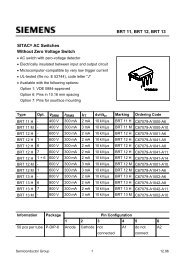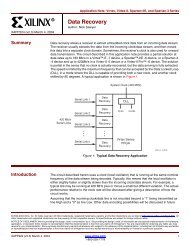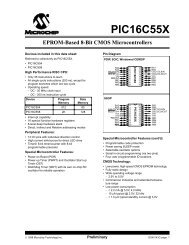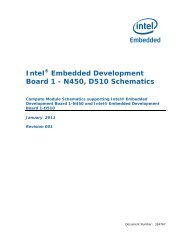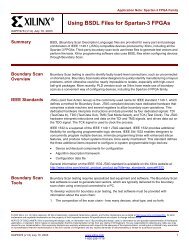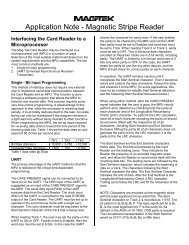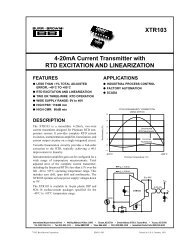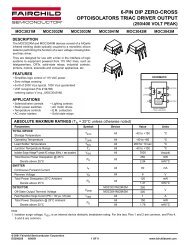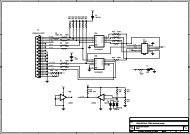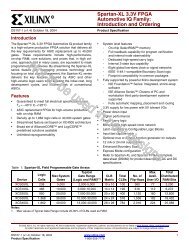Programmable Logic Design Quick Start Handbook
Programmable Logic Design Quick Start Handbook
Programmable Logic Design Quick Start Handbook
You also want an ePaper? Increase the reach of your titles
YUMPU automatically turns print PDFs into web optimized ePapers that Google loves.
PROGRAMMABLE LOGIC DESIGN -- QUICK START HANDBOOK •<br />
Pin-Locking – Rigidly defining and maintaining the functionality and timing<br />
requirements of device pins while the internal logic is still being designed or<br />
modified. Pin-locking has become important, since circuit-board fabrication<br />
times are longer than PLD design implementation times.<br />
PIP – <strong>Programmable</strong> Interconnect Point. In Xilinx FPGAs, a point where<br />
two signal lines can be connected, as determined by the device configuration.<br />
Placement – In FPGAs, the process of assigning specific parts of the design<br />
to specific locations (CLBs) on the chip. Usually done automatically.<br />
PLA – <strong>Programmable</strong> <strong>Logic</strong> Array. The first and most flexible programmable<br />
logic configuration with two programmable planes providing any combination<br />
of “AND” and “OR” gates and sharing of AND terms across multiple ORs.<br />
This architecture is implemented in CoolRunner and CoolRunner-II devices.<br />
PLD – <strong>Programmable</strong> <strong>Logic</strong> Device. Most generic name for all programmable<br />
logic: PALs, CPLDs, and FPGAs.<br />
QML – Qualified Manufacturing Line. For example, ISO9000.<br />
Routing – The interconnection, or the process of creating the desired interconnection,<br />
of logic cells to make them perform the desired function. Routing<br />
follows partitioning and placement.<br />
Schematic – Graphic representation of a logic design in the form of interconnected<br />
gates, flip-flops, and larger blocks. Older and more visually intuitive<br />
alternative to the increasingly more popular equation-based or high-level language<br />
text description of a logic design.<br />
SelectRAM – Xilinx-specific name for a small RAM (usually 16 bits), implemented<br />
in a LUT.<br />
Simulation – Computer modeling of logic and (sometimes) timing behavior<br />
of logic driven by simulation inputs (stimuli or vectors).<br />
SPROM – Serial <strong>Programmable</strong> Read-Only Memory. Non-volatile memory<br />
device that can store the FPGA configuration bitstream. The SPROM has a<br />
built-in address counter, receives a clock, and outputs a serial bitstream.<br />
SRAM – Static Random Access Memory. Read-write memory with data<br />
stored in latches. Faster than DRAM and with simpler timing requirements, but<br />
smaller in size and about four times as expensive than DRAM of the same<br />
capacity.<br />
SRL16 – Shift Register LUT, an alternative mode of operation for every<br />
function generator (LUT) that are part of every CLB in Virtex and Spartan<br />
FPGAs. This mode increases the number of flip-flops by 16. Adding flip-flops<br />
enables fast pipelining – ideal in DSP applications.<br />
Static Timing – Detailed description of on-chip logic and interconnect<br />
delays.<br />
Sub-Micron – The smallest feature size is usually expressed in micron (µ =<br />
millionth of a meter, or thousandth of a millimeter) The state of the art is moving<br />
Xilinx • 188



